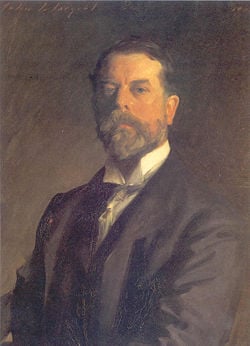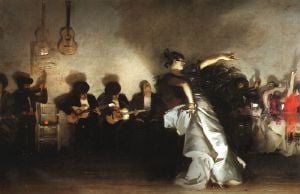John Singer Sargent
John Singer Sargent (January 12, 1856 – April 14, 1925) was the most successful portrait painter of his era, as well as a gifted landscape painter and watercolorist. Sargent was born in Florence, Italy to American parents. He studied in Italy and Germany, and then in Paris under Emile Auguste Carolus-Duran.
Biography
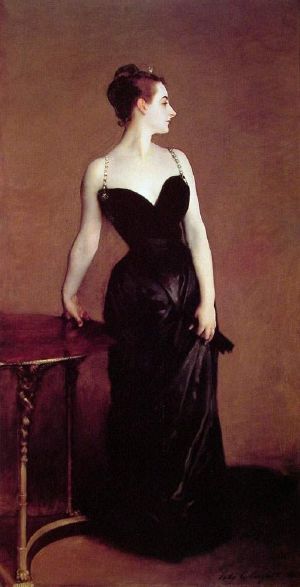
Training
Sargent studied with Carolus-Duran, whose influence would be pivotal, from 1874-1878. Carolus-Duran's atelier was progressive, dispensing with the traditional academic approach which required careful drawing and underpainting, in favor of the alla prima method of working directly on the canvas with a loaded brush, derived from Diego Velázquez. It was an approach which relied on the proper placement of tones of paint.[1]
In 1879 Sargent painted a portrait of Carolus-Duran; the virtuoso effort met with public approval, and announced the direction his mature work would take. Its showing at the Paris Salon was both a tribute to his teacher and an advertisement for portrait commissions.[2]
Madame X and controversy
He continued to receive positive critical notice in the early 1880s, for his portraits; mostly full-length portrayals of women: Madame Edouard Pailleron in 1880, Madame Ramón Subercaseaux in 1881, and Lady with the Rose, 1882. ref>Ormond, Richard: "Sargent's Art," John Singer Sargent, page 25-7. Tate Gallery, 1998.</ref>
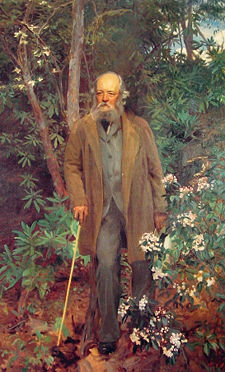
Sargent's best portraits reveal the individuality and personality of the sitters; Some have compared him to Velazquez, who was one of Sargent's great influences. The Daughters of Edward Darley Boit, 1882, a haunting interior which echoes Velázquez' Las Meninas.[3] Sargent's Portrait of Madame X, done in 1884, is now considered one of his best works, and was the artist's personal favorite; eventually Sargent sold it to the Metropolitan Museum of Art. However, at the time it was unveiled in Paris at the 1884 Salon, it aroused such a negative reaction that it prompted Sargent to move to London.[4] Prior to the Mme. X. scandal of 1884, he had painted exotic beauties such as Rosina Ferrara of Capri, and the Spanish expatriate model, Carmela Bertagna, but the earlier pictures had not been intended for broad public reception.
Other Portraits
Before his arrival in England Sargent began sending paintings for exhibition at the Royal Academy. These included the portraits of Dr. Pozzi at Home, 1881, a flamboyant essay in red, and the more traditional Mrs. Henry White, 1883. The ensuing portrait commissions encouraged Sargent to finalize his move to London in 1886.[5] His first major success at the Royal Academy came in 1887, with the enthusiastic response to Carnation, Lily, Lily, Rose, a large piece, painted on site, of two young girls lighting lanterns in an English garden. The painting was immediately purchased by the Tate Gallery. In 1894 Sargent was elected an associate of the Royal Academy, and was made a full member three years later. In the 1890s he averaged fourteen portrait commissions per year, none more beautiful than the genteel Lady Agnew of Lochnaw, 1892. As a portrait painter in the grand manner, Sargent's success was unmatched; his subjects were at once ennobled and often possessed of nervous energy (Mrs. Hugh Hammersley, 1892). With little fear of contradiction, Sargent was referred to as 'the Van Dyck of our times'.[6]
Sargent painted a series of three portraits of Robert Louis Stevenson. The second, Portrait of Robert Louis Stevenson and his Wife (1885), was one of his best known.[7] He also completed portraits of two U.S. presidents: Theodore Roosevelt and Woodrow Wilson.
Landscapes and other work
During the greater part of Sargent's career, he created roughly 900 oil paintings and more than 2,000 watercolours, as well as countless sketches and charcoal drawings. From 1907[8] on Sargent forsook portrait painting and focused on landscapes in his later years; [9] he also sculpted later in life. His oeuvre documents worldwide travel, from Venice to the Tyrol, Corfu, Montana and Florida, and each destination offered pictorial treasure. As a concession to the insatiable demand of wealthy patrons for portraits, however, he continued to dash off rapid charcoal portrait sketches for them, which he called "Mugs." Forty-six of these, spanning the years 1890-1916, were exhibited at the Royal Society of Portrait Painters in 1916.[10]
Sargent is usually not thought of as an Impressionist painter, but he sometimes used impressionistic techniques to great effect, and his Claude Monet Painting at the Edge of a Wood is rendered in his own version of the impressionist style.

Although Sargent was an American expatriate, he returned to the United States many times, often to answer the demand for commissioned portraits. Many of his most important works are in museums in the U.S.; in 1909 he exhibited eighty-six watercolours in New York City, eighty-three of which were bought by the Brooklyn Museum.[11] His mural decorations grace the Boston Public Library.[12] For this commission, a series of oils on the theme of The Triumph of Religion that were attached to the walls of the library by means of marouflage, Sargent made numerous visits to the United States in the last decade of his life, including a stay of two full years from 1915-1917.[13]
It is in some of his late works where one senses Sargent painting most purely for himself. His watercolors, often of landscapes documenting his travels (Santa Maria della Salute, 1904, Brooklyn Museum of Art), were executed with a joyful fluidness. In watercolours and oils he portrayed his friends and family dressed in Orientalist costume, relaxing in brightly lit landscapes that allowed for a more vivid palette and experimental handling than did his commissions (The Chess Game, 1906).[14]
Relationships
Among the artists with whom Sargent associated were Dennis Miller Bunker, Carroll Beckwith, Edwin Austin Abbey (who also worked on the Boston Public Library murals), Francis David Millet, Wilfrid de Glehn, Jane Emmet de Glehn and Claude Monet, whom Sargent painted. Sargent developed a life-long friendship with fellow painter Paul César Helleu, whom he met in Paris in 1878 when Sargent was 22 and Helleu was 18. Sargent painted both Helleu and his wife Alice on several occasions, most memorably in the impressionistic Paul Helleu Sketching with his Wife, 1889. His supporters included Henry James, Isabella Stewart Gardner (who commissioned and purchased works from Sargent, and sought his advice on other acquisitions),[15] and Edward VII, whose recommendation for knighthood the artist declined.[16]
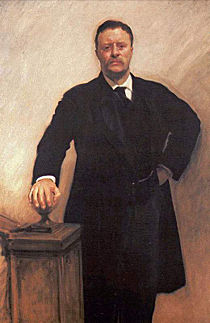
Sargent was extremely private regarding his personal life, Some scholars have suggested that Sargent was homosexual However, there were many friendships with women as well. The likelihood of an affair with Louise Burkhardt, the model for Lady with the Rose, is accepted by Sargent scholars.[17]
Legacy
In a time when the art world focused, in turn, on Impressionism, Fauvism, and Cubism, Sargent practiced his own form of Realism, which brilliantly referenced Velázquez, Van Dyck, and Gainsborough. His seemingly effortless facility for paraphrasing the masters in a contemporary fashion led to a stream of commissioned portraits of remarkable virtuosity (Arsène Vigeant, 1885, Musées de Metz ; Mr. and Mrs. Isaac Newton Phelps-Stokes, 1897, Metropolitan Museum of Art, New York) and earned Sargent the moniker, "the Van Dyck of our times." Still, during his life his work engendered critical responses from some of his colleagues: Camille Pissarro wrote "he is not an enthusiast but rather an adroit performer",[18] and Walter Sickert published a satirical turn under the heading "Sargentolatry".[19] By the time of his death he was dismissed as an anachronism,[20] a relic of the Gilded Age and out of step with the artistic sentiments of post-World War I Europe. Foremost of Sargent's detractors was the influential English art critic Roger Fry, of the Bloomsbury Group, who at the 1926 Sargent retrospective in London dismissed Sargent's work as lacking aesthetic quality.[21]
Despite a long period of critical disfavor, Sargent's popularity has increased steadily since the 1960s, and Sargent has been the subject of recent large-scale exhibitions in major museums, including a retrospective exhibition at the Whitney Museum of American Art in 1986, and a 1999 "blockbuster" travelling show that exhibited at the Museum of Fine Arts, Boston, the National Gallery of Art Washington, and the National Gallery, London.
It has been suggested that the exotic qualities[22] inherent in his work appealed to the sympathies of the Jewish clients whom he painted from the 1890s on. Nowhere is this more apparent than in his portrait Almina, Daughter of Asher Wertheimer (1908), in which the subject is seen wearing a Persian costume, a pearl encrusted turban, and strumming an Indian sarod, accoutrements all meant to convey sensuality and mystery. If Sargent used this portrait to explore issues of sexuality and identity, it seems to have met with the satisfaction of the subject's father, Asher Wertheimer, a wealthy Jewish art dealer living in London, who commissioned from Sargent a series of a dozen portraits of his family, the artist's largest commission from a single patron.[23] The paintings reveal a pleasant familiarity between the artist and his subjects. Wertheimer bequeathed most of the paintings to the National Gallery.[24]
John Singer Sargent is interred in Brookwood Cemetery near Woking, Surrey.[25]
Posthumous sales
Portrait of Robert Louis Stevenson and his Wife sold in 2004 for $8.8 million to Las Vegas casino mogul Steve Wynn to be installed at his newest casino, Wynn Las Vegas.
In December 2004, Group with Parasols (A Siesta) (1905) sold for $US 23.5 million, nearly double the Sotheby's estimate of $12 million. The previous highest price for a Sargent painting was $US 11 million.[26]
Selected works
- Portrait of Madame Edouard Pailleron (1880) Corcoran Gallery of Art
- Portrait of Mrs. Thomas Lincoln Manson Jr. (ca. 1890) Honolulu Academy of Arts
- Portrait of Madame Ramón Subercaseaux (1881) Private collection
- Dr. Pozzi at Home (1881) Hammer Museum
- Lady with the Rose (1882) Metropolitan Museum of Art
- El Jaleo (1882) Isabella Stewart Gardner Museum
- The Daughters of Edward Darley Boit (1882) Boston Museum of Fine Art
- Portrait of Mrs. Henry White (1883) Corcoran Gallery of Art
- Portrait of Madame X (1884) Metropolitan Museum of Art
- Portrait of Robert Louis Stevenson and his wife (1885) Private collection
- Portrait of Arsène Vigeant (1885) Musées de Metz
- Claude Monet Painting by the Edge of a Wood (1885) Tate Collection
- Carnation, Lily, Lily, Rose (1885-6) Tate Collection
- Boston Public Library murals (1890-1919) Boston Public Library
- Portrait of Isabella Stewart Gardner (1888)
- Portrait of the composer Gabriel Fauré (1889) Paris Museum of Music
- La Carmencita. Portrait of the dancer Carmencita. Musee d'Orsay, Paris (1890)
- Portrait of Mrs. Hugh Hammersley (1892) Metropolitan Museum of Art
- Lady Agnew of Lochnaw (1892) National Galleries of Scotland
- Portrait of Frederick Law Olmsted (1895)
- Portrait of Mr. and Mrs. Isaac Newton Phelps-Stokes (1897) Metropolitan Museum of Art
- On his holidays (1901) Lady Lever Art Gallery
- Portrait of Theodore Roosevelt (1903) White House
- Santa Maria della Salute (1904) Brooklyn Museum of Art
- The Chess Game (1906) Harvard Club of New York City
- Portrait of Almina, Daughter of Asher Wertheimer (1908) Tate Collection
- Portrait of John D. Rockefeller (1917)
- Portrait of Grace Curzon, Marchioness Curzon of Kedleston (1925)
Notes
- ↑ Elizabeth Prettejohn: Interpreting Sargent, page 9. Stewart, Tabori & Chang, 1998.
- ↑ Prettejohn, page 14, 1998.
- ↑ Ormond, page 27, 1998.
- ↑ Writing of the reaction of visitors, Judith Gautier observed: "Is it a woman? a chimera, the figure of a unicorn rearing as on a heraldic coat of arms or perhaps the work of some oriental decorative artist to whom the human form is forbidden and who, wishing to be reminded of woman, has drawn the delicious arabesque? No, it is none of these things, but rather the precise image of a modern woman scrupulously drawn by a painter who is a master of his art." Cited in Ormond, pages 27-8, 1998.
- ↑ Notwithstanding the Madame X scandal, "There had been talk of his moving to London as early as 1882, he had been urged to do so repeatedly by his new friend, the novelist Henry James, and in retrospect his transfer to London may be seen to have been inevitable." Ormond, page 28, 1998.
- ↑ Ormond, page 28-35, 1998.
- ↑ John Singer Sargent Virtual Gallery, "Robert Lewis Stevenson and his Wife"
- ↑ "In the history of portraiture there is no other instance of a major figure abandoning his profession and shutting up shop in such a peremptory way." Ormond, Page 38, 1998.
- ↑ In 1925, soon before he died, Sargent painted his last oil portrait, a canvas of Grace Curzon, Marchioness Curzon of Kedleston. The painting was purchased in 1936 by The Currier Museum of Art, where it is currently on display. Currier Museum of Art, "Grace Elvina, Marchioness Curzon of Kedleston" retrieved 4/5/2007 Currier Museum
- ↑ John Singer Sargent Virtual Gallery, "Royal Society of Portrait Painters"
- ↑ Ormond, page 276, 1998.
- ↑ The Sargent Murals at the Boston Public Library
- ↑ Kilmurray, Elaine: "Chronology of Travels," Sargent Abroad, page 242. Abbeville Press, 1997.
- ↑ Prettejohn, page 66-69, 1998.
- ↑ Kilmurray, Elaine: "Traveling Companions," Sargent Abroad, page 57-8. Abbeville Press, 1997.
- ↑ Kilmurray: "Chronology of Travels," page 240, 1997.
- ↑ Ormond, page 14, 1998.
- ↑ Rewald, John: Camille Pissarro: Letters to his Son Lucien, page 183. Routledge & Kegan Paul, 1980.
- ↑ Ormond, page 276, 1998.
- ↑ Prettejohn, page 73, 1998. Prettejohn suggests that the decline of Sargent's reputation was due partly to the rise of anti-Semitism, and the resultant intolerance of 'celebrations of Jewish prosperity'.
- ↑ 'Wonderful indeed, but most wonderful that this wonderful performance should ever have been confused with that of an artist.' Prettejohn, page 73, 1998.
- ↑ Sargent's friend Vernon Lee referred to the artist's "outspoken love of the exotic...the unavowed love of rare kinds of beauty, for incredible types of elegance." Charteris, Evan: John Sargent, page 252. London and New York, 1927.
- ↑ Ormond, page 169-171, 1998.
- ↑ Ormond, page 148, 1998.
- ↑ John Singer Sargent. Necropolis Notables. The Brookwood Cemetery Society. Retrieved 2007-02-23.
- ↑ The Age, 3 December, 2004
ReferencesISBN links support NWE through referral fees
- Fairbrother, Trevor: John Singer Sargent: The Sensualist (2001), ISBN 0-300-08744-6
- Kilmurray, Elainen: Sargent Abroad, Abbeville Press, 1997.
- Noël, Benoît et Jean Hournon: Portrait de Madame X in Parisiana - la Capitale des arts au XIXème siècle, Les Presses Franciliennes, Paris, (2006).
- Ormond, Richard: "Sargent's Art" in John Singer Sargent Tate Gallery, (1998).
- Prettejohn, Elizabeth: Interpreting Sargent, Stewart, Tabori & Chang, (1998).
- Rewald, John: Camille Pissarro: Letters to his Son Lucien, Routledge & Kegan Paul (1980).
- Rewald, John: The John Hay Whitney Collection, National Gallery of Art, Washington (1983). ISBN 0-89468-066-8
External links
- "Home Page", John Singer Sargent Virtual Gallery, Retrieved July 24, 2007.
- "Sargent at Harvard", Harvard University Art Museums, Retrieved July 24, 2007.
- "Home Page", The Sargent Murals at the Boston Public Library, Retrieved July 24, 2007.
- "Sargent, John Singer", WebMuseum, Retrieved July 24, 2007.
- "Home Page", John Singer Sargent- American Painter, Retrieved July 24, 2007.
Credits
New World Encyclopedia writers and editors rewrote and completed the Wikipedia article in accordance with New World Encyclopedia standards. This article abides by terms of the Creative Commons CC-by-sa 3.0 License (CC-by-sa), which may be used and disseminated with proper attribution. Credit is due under the terms of this license that can reference both the New World Encyclopedia contributors and the selfless volunteer contributors of the Wikimedia Foundation. To cite this article click here for a list of acceptable citing formats.The history of earlier contributions by wikipedians is accessible to researchers here:
The history of this article since it was imported to New World Encyclopedia:
Note: Some restrictions may apply to use of individual images which are separately licensed.
